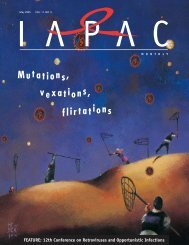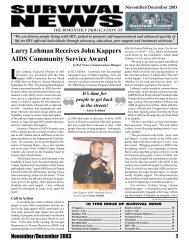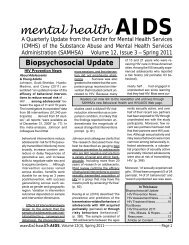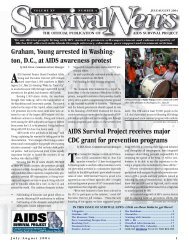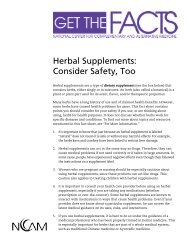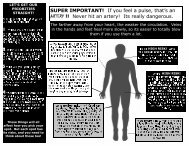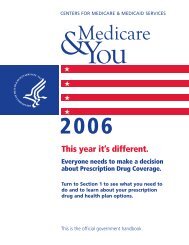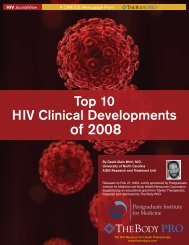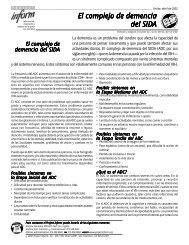The Positive Side (Winter 2013) - CD8 T cells - The Body
The Positive Side (Winter 2013) - CD8 T cells - The Body
The Positive Side (Winter 2013) - CD8 T cells - The Body
You also want an ePaper? Increase the reach of your titles
YUMPU automatically turns print PDFs into web optimized ePapers that Google loves.
successful HIV treatment. Dr. Julio Montaner, director of the<br />
BC Centre for Excellence in HIV/AIDS, stresses the importance<br />
of identifying sleep disturbances caused by HIV treatment<br />
early: “It is my job to be proactive and monitor for<br />
potential side effects. <strong>The</strong> more I can support people’s HIV<br />
treatment and help them be free of side effects, the more<br />
they are likely to be able to adhere to their medication regimen.<br />
Patients should be encouraged to bring up issues<br />
early as opposed to suffering in silence.”<br />
GettinG to tHe root oF tHe Problem<br />
Identifying the nature of a sleep problem and figuring<br />
out what’s behind it is step number one, best done in conversation<br />
with a knowledgeable doctor or nurse. For people<br />
with HIV, the root cause tends to be one or some combination<br />
of the following:<br />
● HIV itself – HIV-infected <strong>cells</strong> in the brain, which produce<br />
neurotoxins and chemical signals that may impair the<br />
sleep of some people.<br />
● medications – such as efavirenz (Sustiva, also found in<br />
Atripla) used to treat HIV, interferon used to treat hepatitis<br />
C and other drugs prescribed for HIV-related illnesses.<br />
● mental health issues – such as depression and anxiety.<br />
● alcohol and drug use – heavy drinking or using drugs,<br />
especially stimulants such as cocaine, speed and ecstasy.<br />
Other causes of sleep problems can include changing<br />
hormone levels (for example, high or low levels of thyroid<br />
hormone, changes in estrogen levels during menopause and<br />
declining levels of free testosterone), calcium and/or vitamin<br />
B12 deficiencies, and infections (including a cold or flu).<br />
After years of tossing and turning, Jasmine was determined<br />
to pinpoint the cause of her problems. <strong>The</strong> efavirenz<br />
she was taking as part of her HIV treatment was a possible<br />
culprit but not an obvious one because she had been taking<br />
the medication for years without side effects. <strong>The</strong> vivid<br />
dreams, nightmares and insomnia that some experience<br />
when taking this drug normally occur when people start<br />
the medication and tend to diminish or go away with time.<br />
But when Jasmine switched HIV drugs, it was confirmed:<br />
“My sleep was much better within days. It was definitely<br />
one of the things that had been causing me problems.”<br />
Working nights was another—but more about that later.<br />
How sleeP works<br />
When we sleep, we alternate between periods of nonrapid<br />
eye movement (NREM) and rapid eye movement (REM).<br />
One cycle takes about 90 minutes to complete and typically<br />
consists of five stages. Stage 1 is a drowsy sleep that usually<br />
lasts five to 10 minutes. During stage 2, our muscle activity<br />
diminishes and body temperature drops as we lose consciousness.<br />
Stages 3 and 4 are characterized by a deep,<br />
restorative sleep when the growth hormone responsible for<br />
cellular regeneration and muscle development is released.<br />
Stage 5 is REM sleep: Our eyes move back and forth rapidly<br />
and dreaming occurs as a result of increased brain activity.<br />
People’s sleep needs vary, but most of us need seven to<br />
nine hours per night. This is known as “sleep architecture”—<br />
24 THE POSITIVE SIDE <strong>Winter</strong> <strong>2013</strong><br />
the total time asleep and the duration of NREM and REM<br />
periods. A good night’s sleep depends on the right balance<br />
between these different stages. Various factors, such as light,<br />
stimulants and poor sleep hygiene, can disrupt this balance.<br />
<strong>The</strong> goal for insomniacs is to restore this balance.<br />
StrAteGiezzz…<br />
Finding the solution that’s right for you might not happen<br />
overnight, but persistence and trying different strategies<br />
with the support of a knowledgeable doctor can go a<br />
long way. Here are some suggestions:<br />
stay away from the light! Light at night is one reason<br />
why many people don’t get enough sleep. Our circadian<br />
rhythms respond to the light and dark around us. Derived<br />
Identifying the<br />
nature of a sleep<br />
problem and figuring<br />
out what’s behind it<br />
is step #1.<br />
from the Latin words circa and diem, meaning “around a<br />
day,” the term describes our sleep/wake pattern, hormone<br />
release, body temperature and other bodily functions over<br />
a 24-hour period. In the past, people would wake up with<br />
the sun and go to bed with the moon, but the lightbulb<br />
changed all that. Bathed in artificial light long after the sun<br />
has set, many of us find our patterns out of sync with our<br />
body’s biological clock. And our sleep suffers from it.<br />
(Research suggests that it may also contribute to cancer,<br />
diabetes, heart disease and obesity.)<br />
In the absence of light, our bodies release the hormone<br />
melatonin, which helps us get to sleep. When we are<br />
exposed to light, the release of melatonin is suppressed and<br />
makes sleep more difficult. Any kind of light has this effect,<br />
but the “blue light” emitted from electronic devices makes it<br />
particularly easy to disregard the body’s readiness for<br />
sleep. That is why it is important to sleep in total darkness.<br />
<strong>The</strong> best way to achieve this is with a specialized window<br />
covering that blocks outside light (a “blackout blind”), but<br />
a sleep mask is effective as well. It is also important to eliminate<br />
all sources of light in the bedroom, including all



